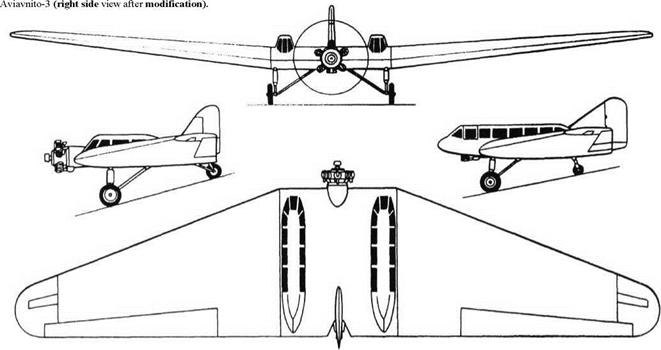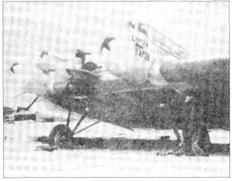Kharkov KhAI Aviaviiito 3, Sergei Kirov
Purpose: To create a light transport with minimum operating cost.
Design Bureau: Kharkov Aviation Institute, Aviavnito brigade led by Aleksandr Alekseyevich Lazarev.
In the 1930s several Soviet designers produced aircraft intended to demonstrate how much could be transported on the l00hp of an M-l 1 engine. These aircraft were as a class called Planerlyet (motor glider). This example had an unconventional configuration. It first flew on 14th September 1936, dual-controlled by V A Borodin and E I Schwartz. Eventually a control linkage was found which by 27th September enabled good turns to be made. Shavrov’s account ends with The
|
Aviavnito-3 after modification.
|
overall conclusion of the tests at Nil GVF (civil aviation test institute) was extremely positive’, but nothing came of this one-off.
The Aviavnito-3 (often incorrectly called KhAI-3) was essentially an all-wing aircraft. The wing comprised a rectangular centre section, with the uncowled engine mounted on steel tubes on the front, to which were bolted two outer panels tapered on the leading edge. Aerofoil was V-106, with a t/c ratio of 14 per cent over the centre section, which had a chord of 5.0m (16ft Sin), tapering to 7 per cent at the tips, which incorporated 8° washout. Structurally, the centre section was KhMA steel tube covered by Dl Dural skin, while the outer panels were all wood, with truss ribs supporting closely spaced stringers. Along each outer edge of the centre section was a row of four seats, each front seat being for a pilot (the two pilots had to agree in advance which one should do the flying), covered by a row of sliding canopies. The flight controls comprised large unbalanced cable-operated surfaces divided into inner and outer sections to serve as ailerons and elevators. In addition, spoilers were recessed into the upper surface of each wingtip, driven by the pedals, to enable co-ordinated turns to be made. A 2m2 (21.5ft2) fin and rudder were added, but it was hoped eventually to do without this. The simple rubber-sprung main landing gears had 800 x 150mm tyres with brakes, and the large tailwheel could castor ±25°. Between the
rows of seats were four Dl tanks giving an 8-hour endurance. During development two additional seats were inserted on each side, pushing the pilots into noses projecting ahead of the wing. To balance these the vertical tail was significantly enlarged.
It is clear that this machine did everything expected of it, and that it was eventually developed to fly safely and controllably. However, even though they were much faster than anything else over vast areas devoid of surface transport, nothing came of the rash of Planerlyet designs.
|
Dimensions (final form) Span Length Wing area |
22.4m 6.8m 78.6 m! |
73 ft 6 in 22 ft 334 in 846 ff |
|
Weights |
||
|
Empty |
1,440kg |
3,1751b |
|
Fuel/oil |
200kg |
440 Ib |
|
Loaded |
2,200kg |
4,850 Ib |
|
Performance |
||
|
Maximum speed |
135km/h |
84 mph |
|
Cruising speed |
115km/h |
71.5 mph |
|
Time to climb to 1 ,000 m |
25min |
(3,281 ft) |
|
Service ceiling approx |
2,000m |
6,561 ft |
|
Range |
850km |
528 miles |
|
Take-off run |
210m |
689ft |
|
Landing speed |
60km/h |
37 mph |












